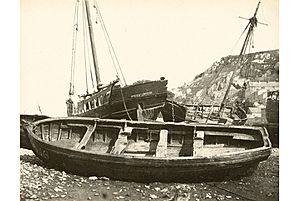Hugh Owen (photographer) facts for kids
Hugh Owen (1808–1897) was one of the very first amateur photographers in the United Kingdom. He was known for his early work with a special photography method called the calotype process. His photos helped capture important moments in history, like the famous Great Exhibition.
Contents
Early Life
Hugh Owen was born in England in 1808. We don't know exactly where he was born, but most people think it was Bristol. Some sources suggest he might have been born in Shropshire. He worked as the chief cashier for the Great Western Railway, which was a big company run by Isambard Kingdom Brunel. In 1846, his first wife, Mary Anne, sadly died in a house fire. Many people believe that Owen started taking an interest in photography soon after this, perhaps as a way to cope with his loss.
Discovering Photography
Hugh Owen probably learned about paper negative photography from Henry Fox Talbot. Talbot was a very important person in the early days of photography. Owen worked hard to improve the silver calotype process at his home in Bristol. This was a complex way to make photos. It involved making paper sensitive to light using a special silver nitrate liquid. This would create images on wet plates.
Owen's photography skills quickly got noticed. In 1847, he became an early member of the Edinburgh Calotype Club. He also helped start the Photographic Society of London. He attended its first meeting in 1853. Owen didn't like the newer collodion process much, even though it soon became more popular than the calotype method.
Photography at the Great Exhibition
Hugh Owen's calotype photos were shown at the amazing Great Exhibition in London in 1851. This was a huge event that showed off new inventions and art from around the world. His pictures impressed the people in charge so much that they asked him to take 155 photographs of the exhibits. He worked alongside a French photographer named Claude-Marie Ferrier.
More than 140 special books were made with these photos and reports. They were called Exhibition of the Works of Industry of All Nations, 1851: Reports by the Juries on the Subjects in the Thirty Classes into which the Exhibition was Divided. These books were given to important people like Queen Victoria, leaders of other countries, and the British Museum. These photos are still Owen's most famous works. They show how he liked to focus on single objects very clearly, often with dark backgrounds.
Owen also showed his work at the Royal Society of Arts in 1852. A review in The Times newspaper said he was one of the best photographers of his time. He usually stayed close to his home in Bristol. However, he did visit Portugal around 1853 or 1854. There, he met other amateur photographers like Joseph James Forrester and probably Frederick William Flower.
Even though he stopped taking photos relatively early, Owen stayed busy with historical preservation. He wrote a well-known book called Two Centuries of Ceramic Art in Bristol. He also gave his collection of ceramic art to the Bristol City Museum and Art Gallery. He became a Fellow of the Society of Antiquaries of London, which is a group dedicated to studying old things.
Later Life and Legacy
Hugh Owen passed away in 1897. For a long time, historians didn't pay much attention to his work. However, many of his photographs are now kept in museums and private collections. You can find his photos in the City of Bristol archives, the Metropolitan Museum of Art in New York City, the J. Paul Getty Museum in Los Angeles, and the Los Angeles County Museum of Art.
A photographer and historian from Bristol named Reece Winstone collected many of Owen's photos. Because of this, an exhibition of Owen's landscape pictures was held in New York City in 2016. It was called Hugh Owen Rediscovered. This was the first exhibition just for his work since the 1800s!
Reece Winstone had been looking for Owen's photos since the 1950s. In 1962, an older gentleman named W. L. Venn went to one of Winstone's exhibitions. Venn had worked for an amateur archaeologist named Canon R. T. Cole. When Cole died, Venn bought his collection of Owen's work. He later gave this album, which had 100 photographs, to Winstone for his collection.


